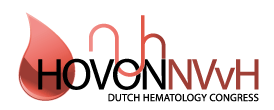Incidence, primary treatment and survival in patients with blastic plasmacytoid dendritic cell neoplasm in the Netherlands
Blastic plasmacytoid dendritic cell neoplasm (BPDCN) is a rare hematologic malignancy arising from plasmacytoid dendritic cells precursors, annually affecting approximately 1,000 individuals in Europe. BPDCN is treated using regimens adapted from acute myeloid leukemia (AML), acute lymphoblastic leukemia (ALL), and non-Hodgkin lymphoma protocols. Despite these aggressive treatments, BPDCN is characterized by poor overall survival (OS). Consolidation with allogeneic hematopoietic cell transplantation (allo-HCT) appears to be crucial for improving survival outcomes. In the Netherlands, the incidence of BPDCN and the impact of different treatment modalities on survival are unknown. This study aims to evaluate BPDCN cases over a 20-year period to provide insights into these aspects.
BPDCN patients ≥18 years diagnosed in 2001-2022 were identified in the Netherlands Cancer Registry, with survival follow-up through February 1st, 2024. Patients with disease presenting in skin were defined as skin involvement, patients with bone marrow or lymph nodes presentation as systemic involvement, and patients with bone marrow or lymph nodes and skin presentation were defined as combined involvement. First-line treatment regimens were categorized as AML-like, ALL-like, non-Hodgkin-like, and other therapy (radiotherapy, surgery, hydrea, and tagraxofusp). The primary endpoint was OS and was defined as the time between diagnosis and all-cause-death.
In total, 96 patients were identified between 2001 and 2022 with ≤2 patients per year in the first years and 6 patients in the most contemporary years. With a median age of 73 years (interquartile range [IQR] 60-80), 72 patients (75%) were male, 36 (38%) patients had skin involvement, 25 (26%) had systemic involvement, and 35 (36%) patients had combined involvement. According to treatment regimens, 39 (41%) patients were untreated, 18 (19%) AML-like, 10 (10%) ALL-like, 12 (13%) non-Hodgkin-like and 17 (18%) with other therapy. Median OS was 9 months (IQR 3-17 months). OS was superior for patients with solely skin involvement compared to patients with combined presentation (p=0.03) but was similar to the OS of patients with only systemic involvement (p=0.05). According to type of treatment, survival estimates were similar between AML-like, ALL-like, non-Hodgkin-like and other therapy, although based on limited patient numbers. Patients treated with allo-HCT had an improved 2- and 5- year OS compared to patients without allo-HCT (2-year OS: 57% versus 7%, respectively; 5-year OS: 51% versus 3%, respectively, p<0.01).
In this nationwide population of 96 BPDCN patients, with an average of 6 patients per year, survival is poor with a median OS of 9 months. Patients treated with allo-HCT had superior outcome over patients without consolidation. Our data provide valuable information on the incidence of BPDCN in the Netherlands and a benchmark for comparison with new available treatment options like tagraxofusp.

